Why Keats?
July 19th, 2012
Ah, the vagaries of Google. For some reason, despite all the ink I give on this blog to fashion history, costuming, music, and random 19th-century literature, the bulk of the people who visit my site are looking for John Keats. I swear he isn’t here.
I wonder what I’d do with him if he were? Probably a quarantine…

Speaking of romantic poets who died in unfortunate circumstances, I recently learned that John Clare spent his final years in an insane asylum, where his most famous poem was written.
Brassiere Embroidery
July 18th, 2012
I seem to have a one-track mind lately. When I’m not poring over historical underwear, I’m sewing modern reproductions of it. This is for another Kestos-esque brassiere.
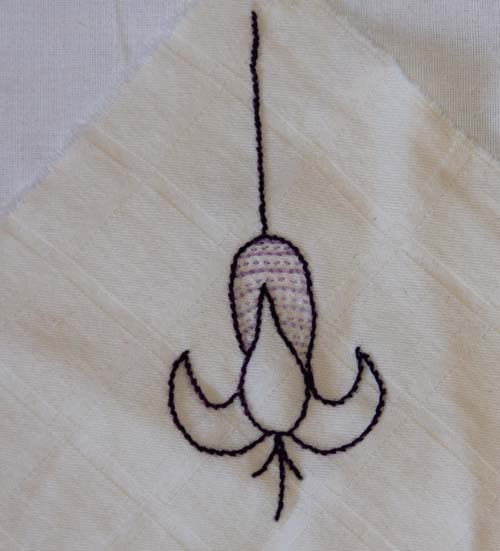
It’s positioned so that the stem will run right into the shoulder strap, and the stamens end just above the bust point. Best of all, since the fabric is cut on the bias, the flower stretches and changes shape with every breath. Of course, it’s unlikely that anyone will see it, since it is, after all, underwear.
I think the stamens need little pale purple dots on each end. I considered beads, but that would be inconvenient for washing. And might look odd under a closely fitted top.
Really, Really Old Underwear
July 17th, 2012
My fascinating friend, and 19th-century warrioress extraordinaire, Rachel posted a link to this article about a recent discovery by the archaeology department of the University of Innsbruck. They seem to have found evidence of hitherto unknown forms of fifteenth-century undergarments in an Austrian castle. If you’ve read any of my previous postings, you know I’m a sucker for a good historical underwear discovery.
The article is a little misleading however, as it doesn’t point out that this brassiere look-a-like is actually missing a large chunk of material that would have covered the stomach from breasts to waist, and likely a back portion that laced on at the sides and anchored the other end of the shoulder straps. See the piece with lacing eyelets hanging down the left side? It probably survived because it was reinforced.
Here’s my hastily drawn rendering of what it might look like with the missing material.

I’m undecided about what’s going on between the breast cups at the top. Is it purposefully left open because fifteenth-century German underdresses (worn over underwear, but under the overdress) often had deep V necks? Or was there a different, finer, or even decorative fabric inserted there? The top edge looks like it was meant to end where it does, but it may also just be impossible to see in the picture that it’s also ripped and the same material once ran all the way across.
I also wonder how much of a revelation this actually is. I’m incredibly ignorant about fifteenth-century Germanic fashion, so I looked it up in “A History of Costume” by Carl Köhler, a 19th-century costume historian. In the section on fifteenth-century German women’s dress, he tells us:
“A chronicler of the day describes this fashion [a new form of dress in the late 1400s) thus: ‘Girls and women wore beautiful wimples, with a broad hem in front, embroidered with silk, pearls, or tinsel, and their underclothing had pouches into which they put their breasts. Nothing like it had ever been seen before.’ “
Hmmmm. But, as I said, I know next to nothing about this period. So I am happy to take the word of those who do that this is a remarkable discovery. There’s another garment featured in the article, and I also have a few ideas about that. But I’ll save them for another post.
In the meantime, if you run across a more scholarly treatment of this topic, please let me know. I’d be anxious to hear some of the finer points describing the findings and why they are so surprising.
Kestos-esque: Version I
July 16th, 2012
After a few nights of contemplative sewing, my first prototype of the Kestos-inspired brassiere is complete. But I’m going to make you read all about how I did it before showing you a picture.
I found a photograph and description of a 1930s Kestos-style brassiere in “Underwear Fashion in Detail,” by Eleri Lynn, published by the V&A. I’d love to show it to you, but it’s probably better if I just tempt you to buy the book instead. At least a portion of the royalties must go to support the museum, so you can look at it as a charitable purchase.

I will, however, go so far as to say that the text explained how the Kestos brassiere was originally conceived; it was inspired by a pair of folded handkerchiefs. So I decided to start with the same premise. I believe ladies’ hankies are usually 10 inches square (gents are 12). So I tore an 11 inch square of thick, buttery cotton (a reclaimed sheet) — 10 inches for the handkerchief, with an extra inch for seam allowances. Then I cut the square in half.
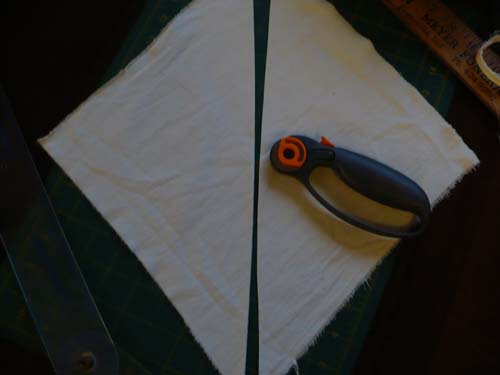
The long bottom of the triangle is the base of each cup of course. Although the resulting pieces were quite malleable, being cut on the bias, they still needed a little shaping. With a half inch dart at the bottom and a quarter inch at the arm, they took on a decidedly bra-like shape.
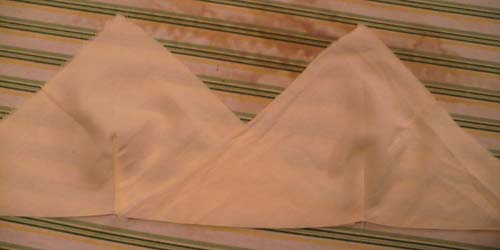
Next came the binding. I used the purple bias tape I’d cut for the petticoat that didn’t work. I’m working on incorporating more machine sewing into my process, now that I have three (count them, 1, 2, 3) sewing machines standing ever at the ready, but it’s a struggle. I did manage to sew the first side of the binding on by machine, clipping and turning neatly at the corners. But I couldn’t resist blindstitching the folded bias on the inside by hand.

There’s an hour (or three) of my life that’s never coming back.
The straps were a bit tricky — I used bias (machine sewn into a tiny tube) for the shoulders and a tube of cream cotton ruched over elastic for the chest straps. Tiny shaped pieces with buttons were felled to the bottom of each cup to complete the fastening.
Voila!

And the back (please excuse my terrible posture, I had a camera on my left shoulder).
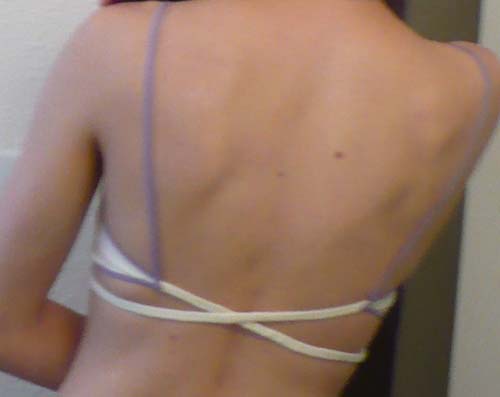
I’m actually quite pleased with the result. It’s definitely more comfortable than anything you can buy at the local lingerie boutique. And it doesn’t rely on double-knit or endless plush elastic or underwire or foam. Some minor fitting issues that need correcting in Version II include shortening the shoulder straps (or making them adjustable), lengthening the back straps just a bit, and pinching a little extra material out of the sides.
Oh, and Version II is going to be embroidered. Why? Just because I can.
P.S. I realize it may be a bit eccentric to post pictures of myself wearing underwear on the internet. But it is definitely better than posting pictures of myself not wearing underwear. And I feel that the informative context in which it is presented must remove any objections on the grounds of taste. Lastly, this covers a sight more than my bathing suit, and I wear that to the public beaches on a regular basis.
Back to the Drawing Board
July 11th, 2012
After a night of solid stitching, much of it by hand (slip-stitched faux french seams, triple-basted and back-stitched bust cups), I was finally ready for the pre-strap and closure fitting of my experimental bodiced petticoat. With the center front pinned neatly together, I stood in front of the mirror and my heart sank. By the time I’d piped and bound the bust cup seams, they were nearly as bulky as an underwire. And it was quite clear that the front closure needed boning, possibly the side seams as well. There was no way the final result would even be as comfortable as a modern brassiere. Which defeats the whole point.
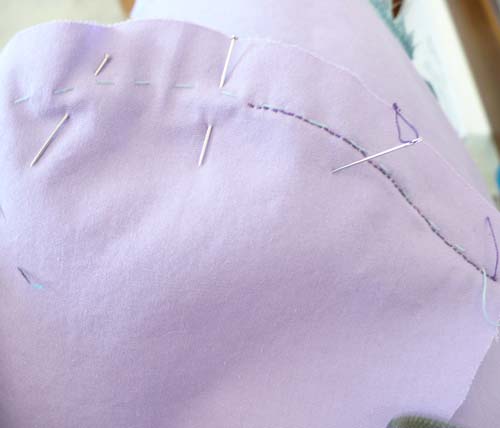
Back-stitching the bulky bust cup seam
So I went back to my books in search of another solution to the underwear problem. I’m aiming for a wardrobe of clothing based on styles popular from about 1900 to 1940. So it seemed logical to look for undergarments from those eras. Chemise with slash and gather bust shaping (I’ve seen one in an historic collection), bust bodice, bandeaux, and/or…
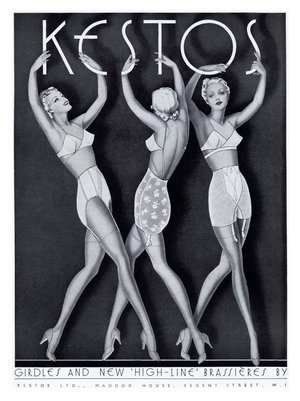
That’s right, a Kestos. Named for Aphrodite’s own support garment, the Kestos was the most popular brassiere of the 1930s. And it was originally designed with a pair of folded linen handkerchiefs connected by elastic and ribbons! What could be more comfortable? Or better suited to my free-form wardrobe?
I think I may also experiment with a few chemise configurations, given my obsession with the chemise form in general. It seems like a useful undergarment for many of the looser styles I have in mind. Petticoats will just have to be separate, which is perhaps more convenient for washing anyways.
« Newer Posts — Older Posts »
